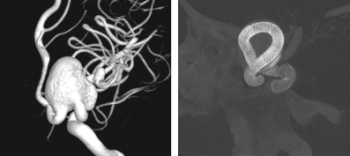
AJNR Editor-in-Chief
Mauricio Castillo
The next generation of devices to treat intracranial aneurysms, flow diverters, is receiving considerable attention in the literature and clinical practice. As such, we decided that recent articles published in AJNR would serve as an excellent launching pad for our new electronic AJNR News Digest. This monthly e-publication will highlight the latest techniques and technology in neuroimaging in a simple, friendly format similar to that now used by the major news and media outlets, and perfectly adapted to tablet browsing.
Wide-neck, giant, fusiform, or very small aneurysms are still a challenge to treat with current endovascular techniques. In April 2012, based on the results of the PUFS study, the FDA approved the use of Pipeline devices for treatment of wide-neck aneurysms of the proximal ICA. Pipelines reroute the flow into the parent artery, changing the hemodynamics away from intra-aneurysmal circulation and inducing progressive thrombosis of the aneurysm. Despite the high rate of aneurysm occlusions, complications such as delayed rupture and more surprising distal intra-parenchymal hemorrhage have been described and, thus, questions concerning long-term outcomes remain. Remote intra-parenchymal hemorrhage appears to be directly associated with the flow-diversion process as distal hemorrhages are not seen in classic stenting and embolization procedures. Published reports speculate on the likelihood that flow-diverting devices could decrease segmental compliance of the stented blood vessels and modify the blood pressure waveforms transmitted to distal cerebral vasculature or result in a thrombus-mediated weakening of the aneurysm walls; however, no
